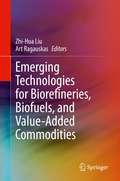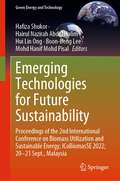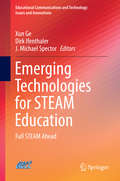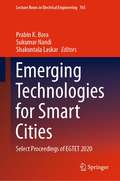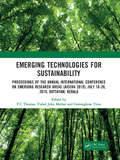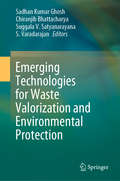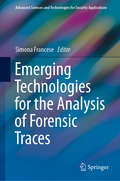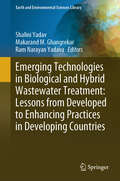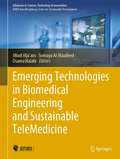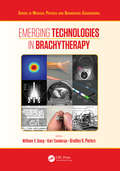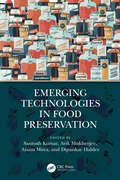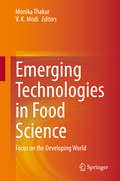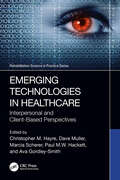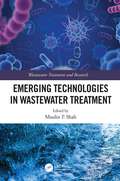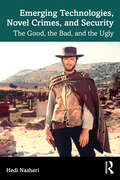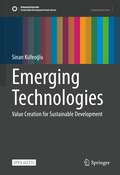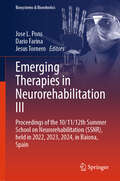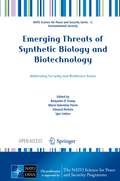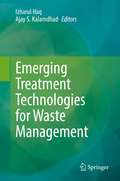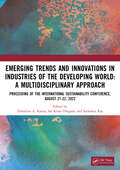- Table View
- List View
Emerging Technologies for Biorefineries, Biofuels, and Value-Added Commodities
by Zhi-Hua Liu Art RagauskasThis book provides in-depth coverage on the latest concepts, systems, and technologies that are being utilized in biorefineries for the production of biofuels and value-added commodities. Written by internationally recognized experts, the book provides a comprehensive overview of pretreatment technology for biorefineries and biofuels, enzymatic hydrolysis and fermentation technology for biofuel production, and lignin valorization for developing new products from waste lignin. The book will be a valuable resource for researchers and professionals working in process engineering, product engineering, material science, and systems and synthetic biology in the fields of biorefining, biofuel, biomaterials, environmental waste utilization, and biotechnology.
Emerging Technologies for Economic Development (Science, Technology and Innovation Studies)
by Leonid Gokhberg Dirk Meissner Ozcan SaritasThis book provides an impressive overview of emerging technologies, especially nanotechnologies and biotechnologies, and their prospective applications. It identifies and describes existing and potential markets for emerging technology-based applications, and projects scenarios for macroeconomic development based on these technologies. Integrated roadmaps for the development of a nano- and bioindustry are shown and policy measures and corporate strategies developed to advance these technologies. These measures are illustrated using roadmaps and policy case studies.The book combines a practical, comprehensive overview of the technical side of emerging technologies and their applications in various fields with an analysis of market developments and characteristics.
Emerging Technologies for Future Sustainability: Proceedings of the 2nd International Conference on Biomass Utilization and Sustainable Energy; ICoBiomasSE 2022; 20–21 Sept., Malaysia (Green Energy and Technology)
by Hafiza Shukor Hui Lin Ong Hairul Nazirah Abdul Halim Boon-Beng Lee Mohd Hanif Mohd PisalThis book presents high-quality peer-reviewed articles from the 2nd International Conference on Biomass Utilization and Sustainable Energy 2022 (ICoBiomasSE 2022) organized by the Centre of Excellence for Biomass Utilization (COEBU), Universiti Malaysia Perlis (UniMAP), Malaysia. The theme of the conference “Emerging Technology for Future Sustainability” is chosen in view of the current revolution and rapid developments in the field of biomass innovation towards sustainable development. The contents are broadly divided into five parts: (1) sustainable biomass resources for decarbonizing the economy, (2) biomass conversion technologies for bioenergy and biofuels, (3) biomass conversion to intermediates and products, (4) bioeconomy sustainability, impacts and policies and (5) bioenergy integration. It provides a platform for students, professionals, researchers, academicians, policymakers and industries working in the areas of biomass utilization and sustainable energy to solve long-standing environmental issues for a healthier planet.
Emerging Technologies for STEAM Education
by Dirk Ifenthaler J. Michael Spector Xun GeThis theory-to-practice guide offers leading-edge ideas for wide-scale curriculum reform in sciences, technology, engineering, the arts, and mathematics--the STEAM subjects. Chapters emphasize the critical importance of current and emerging digital technologies in bringing STEM education up to speed and implementing changes to curricula at the classroom level. Of particular interest are the diverse ways of integrating the liberal arts into STEM course content in mutually reshaping humanities education and scientific education. This framework and its many instructive examples are geared to ensure that both educators and students can become innovative thinkers and effective problem-solvers in a knowledge-based society. Included in the coverage: Reconceptualizing a college science learning experience in the new digital era. Using mobile devices to support formal, informal, and semi-formal learning. Change of attitudes, self-concept, and team dynamics in engineering education. The language arts as foundational for science, technology, engineering, art, and mathematics. Can K-12 math teachers train students to make valid logical reasoning? Moving forward with STEAM education research. Emerging Technologies for STEAM Education equips educators, education researchers, administrators, and education policymakers with curricular and pedagogical strategies for making STEAM education the bedrock of accessible, relevant learning in keeping with today's digital advances.
Emerging Technologies for Smart Cities: Select Proceedings of EGTET 2020 (Lecture Notes in Electrical Engineering #765)
by Sukumar Nandi Prabin K. Bora Shakuntala LaskarThis book comprises the select proceedings of the International Conference on Emerging Global Trends in Engineering and Technology (EGTET 2020), held in Guwahati, India. The chapters in this book focus on the latest cleaner, greener, and efficient technologies being developed for the implementation of smart cities across the world. The broader topical sections include Smart Buildings, Infrastructures and Disaster Management; Smart Governance; Technologies for Smart Cities, and Wireless Connectivity for Smart Cities. This book will cater to students, researchers, industry professionals, and policy making bodies interested and involved in the planning and implementation of smart city projects.
Emerging Technologies for Smart Cities: Sustainable Transport Planning in the Global North and Global South
by Samson Olawale Fadare Trynos Gumbo Oluwayemi-Oniya AderibigbeThis book examines the use of smart city-associated technologies to enhance sustainable transportation planning in cities of both the global north and south, focusing specifically on sustainable transportation. The authors of the book examine technologies and tools such as UAVs, GIS, cutting-edge information and communication technologies, machine learning and big data to assess their potential for reducing traffic, redirecting traffic to assigned routes, monitoring traffic growth and development in our urban centres, with the ultimate aim of reducing congestion/commuting time, accidents, and pollution to promote climate action and a just transition. The book offers a comparative study of transport situation and planning in the developed and developing countries, focusing on the United States of America, Germany and Singapore in the Global North on one hand and South Africa, Nigeria and India from the Global South on the other. As more and more of the world’s population lives in urban centers, proactively monitoring and managing car traffic is essential. The book will be of interest to academics and researchers in the built environment (architecture, urban and regional planning, construction management, quantity surveying, geography), engineering, environmental sciences, social sciences, public policy, design in both the developed and developing countries.
Emerging Technologies for Sustainability: Proceedings of the Annual International Conference on Emerging Research Areas (AICERA 2019), July 18-20, 2019, Kottayam, Kerala
by P. C. Thomas; Vishal John Mathai; Geevarghese TitusThe theme of conference is Emerging Technologies for Sustainability. Sustainability tends to be problem driven and oriented towards guiding decision making. The goal is to raise the global standard of living without increasing the use of resources beyond global sustainable levels. The conference is intended to act as a platform for researchers to share and gain knowledge, showcase their research findings and propose new solutions in policy formulation, design, processing and application of green materials, material selection, analysis, green manufacturing, testing and synthesis, thereby contributing to the creation of a more sustainable world.
Emerging Technologies for Textile Coloration (Emerging Materials and Technologies)
by Mohd YusufThis book features perspectives on advances in textile coloration technologies. It provides a comprehensive and holistic overview, supporting rapid and efficient entry of new researchers into emerging subjects within textile engineering and technology. FEATURES Introduces current, reliable coloration technologies Explains emerging coloration technologies from a multidisciplinary point of view Discusses future R&D opportunities Offers systematic, research-oriented outlines and observations and well-defined illustrative models and schemes Written for academicians, scientists, researchers, and advanced students of textile science and technology, Emerging Technologies for Textile Coloration aims to provide depth of understanding of both state-of-the-art and emergent topics and to spur further research leading to new opportunities and applications.
Emerging Technologies for Waste Valorization and Environmental Protection
by Sadhan Kumar Ghosh Chiranjib Bhattacharya Suggala V. Satyanarayana S. VaradarajanThis book features carefully selected articles on emerging technologies for waste valorization and environmental protection. The term “waste valorization” is used particularly in engineering, economics, technology, business, environmental and policy literature to refer to any unit operation or collection of operations targeted at reusing, recycling, composting or converting wastes into useful products or energy sources without harming the environment. The book discusses the rudimentary concept, and describes a range of emerging technologies in the field, including nano, fuel-cell and membrane technologies, as well as membrane bioreactors. It also examines in detail essential and common processes in waste valorization, such as rigorous chemical engineering applications, mathematical modeling and other trans-disciplinary approaches. The chapters present high-quality research papers from the IconSWM 2018 conference.
Emerging Technologies for the Analysis of Forensic Traces (Advanced Sciences and Technologies for Security Applications)
by Simona FranceseThis book provides a line of communication between academia and end users/practitioners to advance forensic science and boost its contribution to criminal investigations and court cases. By covering the state of the art of promising technologies for the analysis of trace evidence using a controlled vocabulary, this book targets the forensics community as well as, crucially, informing the end users on novel and potential forensic opportunities for the fight against crime. By reporting end users commentaries at the end of each chapter, the relevant academic community is provided with clear indications on where to direct further technological developments in order to meet the law requirements for operational deployment, as well as the specific needs of the end users. Promising chemistry based technologies and analytical techniques as well as techniques that have already shown to various degrees an operational character are covered. The majority of the techniques covered have imaging capabilities, that is the ability to visualize the distribution of the target molecules within the trace evidence recovered. This feature enhances intelligibility of the information making it also accessible to a lay audience such as that typically found with a court jury. Trace evidence discussed in this book include fingermarks, bodily fluids, hair, gunshot residues, soil, ink and questioned documents thus covering a wide range of possible evidence recovered at crime scenes.
Emerging Technologies in Biological and Hybrid Wastewater Treatment: Lessons from Developed to Enhancing Practices in Developing Countries (Earth and Environmental Sciences Library)
by Shalini Yadav Ram Narayan Yadava Makarand M. GhangrekarThis book provides technical information on different biological and hybrid wastewater treatment systems for treatment of wastewater and reuse. The contained information helps in tracking their progress of such systems toward practical and field-scale applications. The book also includes strategies to be adopted for minimizing the losses and maximizing the benefits. Additionally, it includes methods for protecting the environment through the application of advanced biological and hybrid wastewater treatment technology. Furthermore, it discusses the crucial parts that science, technology, and innovation play in the formulation, implementation, and administration of wastewater treatment policy. It highlights the challenges that must be overcome to adopt biological and hybrid wastewater treatment infrastructure regulations successfully and provides some answers. It investigates how the biological and hybrid wastewater treatment technology may be used in a wide variety of field's sets apart from other on-the-shelf publications on the market. Also, it delves into the core concepts of biological and hybrid wastewater treatment systems. It explores how these concepts can be modified to fit a variety of contexts and uses. Applications such as managing facilities, dealing with pandemics, urban wastewater treatment and reuse, farming, and other applications are included in this book. This book is helpful to researchers, entrepreneurs, professionals, planners, policymakers, environmental engineers, and others interested in biological and hybrid wastewater treatment system management strategies through the application of breakthroughs in biological and hybrid wastewater treatment technologies. Also, it is useful as a fundamental source of information and state-of-the-art knowledge to graduate students, university faculties, and researchers in the fields of environmental sciences/engineering, biological and chemical sciences, and NGO. It is also useful to entrepreneurs, professionals, and planners in policy and decision making at the local, state, and national levels for many countries.
Emerging Technologies in Biomedical Engineering and Sustainable TeleMedicine (Advances in Science, Technology & Innovation)
by Somaya Al-Maadeed Jihad Alja’am Osama HalabiThis book presents the most recent research and applications in Biomedical Engineering, electronic health and TeleMedicine. Top-scholars and research leaders in the field contributed to the book. It covers a broad range of applications including smart platforms like DietHub which connects patients with doctors online. The book highlights the advantages of Telemedicine to improve the healthcare services and how it can contribute to the homogenization of medicine without any geographical barriers. Telemedicine transforms local hospitals, with limited services, into a node of an integrated network. In this manner, these nodes start to play an important role in preventive medicine and in high-level management of chronic diseases. The authors also discuss the challenges related to “health informatics” and in “e-health management”. The topics of the book include: synchronous and asynchronous telemedicine with deep discussions on e-health applications, virtual medical assistance, real-time virtual visits, digital telepathology, home health monitoring, and medication adherence, wearable sensors, tele-monitoring hubs and sensors, Internet of Things, augmented and virtual reality as well as e-learning technologies. The scope of the book is quite unique particularly in terms of the application domains that it targets. It is a unique hub for the dissemination of state of the art research in the telemedicine field and healthcare ecosystems. The book is a reference for graduate students, doctors, and researchers to discover the most recent findings, and hence, it achieves breakthroughs and pushes the boundaries in the related fields.
Emerging Technologies in Brachytherapy (Series in Medical Physics and Biomedical Engineering)
by William Y. Song Kari Tanderup Bradley PietersBrachytherapy is continuously advancing. Years of accumulated experience have led to clinical evidence of its benefit in numerous clinical sites such as gynecological, prostate, breast, rectum, ocular, and many other cancers. Brachytherapy continues to expand in its scope of practice and complexity, driven by strong academic and commercial research, by advances in competing modalities, and due to the diversity in the political and economic landscape. It is a true challenge for practicing professionals and students to readily grasp the overarching trends of the field, especially of those technologies and innovative practices that are not yet established but are certainly on the rise. Addressing this challenge, Emerging Technologies in Brachytherapy presents a comprehensive collection of chapters on the latest trending/emerging technologies and expert opinions. It is divided into five broad sections: Section I: Physics of Brachytherapy Section II: Imaging for Brachytherapy Guidance Section III: Brachytherapy Suites Section IV: Is Brachytherapy a Competitive Modality? Section V: Vision 20/20: Industry Perspective Each section has a carefully selected collection of chapters, which covers the spectrum of topics in comprehensive detail. By drawing on recognized experts and key opinion leaders from academia and commercial sectors worldwide (100+ contributors), Emerging Technologies in Brachytherapy provides readers with a wealth of relevant information needed to comprehend the rapidly advancing technologies and trends of today and the prospects for the future.
Emerging Technologies in Food Preservation
by Santosh Kumar Avik Mukherjee Atanu Mitra Dipankar HalderConsumers worldwide are becoming increasingly aware of the significant impacts of food quality, nutrition, and food habits on their health. Demands for fresh, minimally processed foods, foods subjected to less severe preservation and processing, and for foods with no synthetic chemical preservatives are expanding rapidly. Food businesses worldwide are innovating advanced processing and preservation technologies, including natural, bioactive preservatives to fulfill these emerging consumers’ demands. Emerging Technologies in Food Preservation discusses the innovations and advancements in food processing and preservation that have emerged over the last two decades of the 21st century. Various experts in the field examine different innovative food processing and preservation technologies, including non-thermal and minimal processing technologies, particularly those that have least destructive impact on micronutrients. Key Features: Describes the hurdles and challenges in commercialization of these novel processing technologies, including their legal ramifications on food regulations and legislations. Provides detail accounts of application of each of the novel food preservation principles, as they are applied in commercial food processing / food manufacturing lines worldwide. Features a complete account on recent developments and advancements in food preservation and processing technologies, including natural and biopreservatives Mindful of the increasing interest in alternatives to traditional thermal processing of foods and beverages, this book is a valuable reference for students, scholars, researchers, scientists, food entrepreneurs, as well as technical professionals working in food industries and associated businesses.
Emerging Technologies in Food Science: Focus on the Developing World
by Monika Thakur V. K. ModiThis book provides a comprehensive review of recent innovations in food science that are being used to tackle the challenges of food safety, nutritional security and sustainability. With a major focus on developing nations, like India, the book is divided into four main sections. The first section provides an overview of the food industry, while the second explores food safety in various segments, with an interesting account of street food safety – an important, yet often neglected aspect for safety parameters. The third section, on nutritional security and sustainability, explores various ways of maximizing nutrition and optimizing waste management in the food industry. The book closes with a section on emerging technologies and innovations, which introduces readers to some of the latest technologies in the food industry, including advances in food processing, packaging, nanotechnology, etc. The topics have been divided into 25 different chapters, which offer a diverse blend of perspectives on innovations in the developing world. Ideally suited for students and researchers in the food sciences, the book is also an interesting read for industry experts in Food Science and Technology.
Emerging Technologies in Healthcare: Interpersonal and Client Based Perspectives (Rehabilitation Science in Practice Series)
by Christopher M. Hayre, Dave Muller, Marcia Scherer, Paul M.W. Hackett, and Ava Gordley-SmithThis edited book focuses on the role and use of emerging technologies within the healthcare sector. This text draws on expertise from leading practitioners and researchers who either utilize and/or are at the forefront of researching with emerging technology in anticipation of enhancing patient outcomes.Emerging Technologies in Healthcare: Interpersonal and Client-Based Perspectives focuses on the role of emerging technologies in society and how it may enhance medical treatment, management, and rehabilitation of service users. It offers expert perspectives on topics covering emerging technological advances and how they are being incorporated into healthcare, but also critically appraises forthcoming implementation. The editors draw from recent publications and the growing narrative surrounding technological advances, notably telerehabilitation, virtual reality, augmentation, and mHealth. Subsequent chapters focus on these, coupled with other emerging technologies, providing detailed insight into how these can either enhance and/or hinder patient/service user outcomes. Each chapter explores the multifaceted use and application of each emerging technology, that impacts on diagnosis, treatment, and (self-) management of individuals. For example, can emerging technology really facilitate patient diagnosis, improve, or remove practitioner–patient interactions, provide sound rehabilitation, and treat/monitor mental health conditions?This edited volume encompasses an array of emerging technologies that will remain pertinent to caregivers, families, practitioners, service users and policymakers. This is not a text on emerging technology alone but on its societal implications, accompanied by ethical, altruistic, and moral examples for such advances within the healthcare field. It is targeted that this text will enhance and offer original discussions surrounding the interconnectivity of technology and medicine, rehabilitation, and patient care.
Emerging Technologies in Wastewater Treatment (Wastewater Treatment and Research)
by Maulin P. ShahEmerging technologies in wastewater treatment plant is an ecological, profitable and natural technology designed to eliminate heavy metals, radionuclides, xenobiotic compounds, organic waste, pesticides, etc. from contaminated sites or industrial downloads through biological means. Since this technology is used in conditions on site, it does not physically disturb the site unlike conventional methods, that is, chemical or mechanical methods. In this technology, higher plants or microbes are used alone or in combination for the phytoextraction of heavy metals from sites contaminated with metals. Through microbial interventions, metals are immobilized or mobilized through redox conversions in contaminated sites. If they are mobilized, accumulating metal plants are placed to accumulate metals in their bodies. Next, metal-loaded plants are collected and recycled to reduce the volume of waste and then, disposed of as hazardous materials or used for the recovery of precious metals, if possible. In case of immobilization, metals are no longer available to be toxic to organisms. There are very few books published on the proposed theme. A good number of books have been published on environmental bioremediation, but the proposed book is a new and an innovative proposal specifically in wastewater treatment. Looking into the importance of emerging technologies in wastewater treatment research, the book will have a high and applicable value in industrial wastewater treatment research. Features: The book highlights the importance of emerging technologies in the wastewater treatment plant to clean up the environment from pollution caused by human activities. It assesses the potential application of several existing bioremediation techniques and introduces new emerging technologies. It is an updated vision of the existing emerging technologies in environmental bioremediation strategies with their limitations and challenges and their potential application to remove environmental pollutants. It also introduces the new trends and advances in environmental bioremediation with a thorough discussion of recent developments in this field. Highlights the importance of bioremediation to deal with the ever-increasing number of environmental pollutants.
Emerging Technologies, Novel Crimes, and Security: The Good, the Bad, and the Ugly
by Hedi NasheriThis book provides a holistic overview of the complexities of modern technological advances and their implications for crime and security. It examines the societal dilemmas that accompany these technologies, their strategic impact on geopolitics, governments, business, and civil society.The increasingly interconnected world gives rise to novel crimes and creates a new, complex set of threats. Understanding this landscape is essential to strategizing for the prevention, protection, mitigation, and risk assessment of technology-related crime.Practical and approachable, this book builds knowledge and awareness of the impact of emerging technologies on crime and security among professionals, students, academicians, researchers, and policymakers.
Emerging Technologies: Value Creation for Sustainable Development (Sustainable Development Goals Series)
by Sinan KüfeoğluThis monograph investigates a multitude of emerging technologies including 3D printing, 5G, blockchain, and many more to assess their potential for use to further humanity’s shared goal of sustainable development. Through case studies detailing how these technologies are already being used at companies worldwide, author Sinan Küfeoğlu explores how emerging technologies can be used to enhance progress toward each of the seventeen United Nations Sustainable Development Goals and to guarantee economic growth even in the face of challenges such as climate change. To assemble this book, the author explored the business models of 650 companies in order to demonstrate how innovations can be converted into value to support sustainable development. To ensure practical application, only technologies currently on the market and in use actual companies were investigated. This volume will be of great use to academics, policymakers, innovators at the forefront of green business, and anyone else who is interested in novel and innovative business models and how they could help to achieve the Sustainable Development Goals. This is an open access book.
Emerging Technology And Management For Ruminants
by Frank H BakerThe Proceedings of the 1985 International Stockmen's School Seminars, Emerging Technology and Management for Ruminants, includes approximately fifty technical papers given at this year's Stockmen's School, sponsored by Winrock International. The authors are outstanding animal scientists, agribusiness leaders, and livestock producers w
Emerging Technology and Management Trends in Environment and Sustainability: Proceedings of the International Conference, EMTES-2022
by Sushovan Sarkar Shubhangi Gupta Ashok Kumar ShawThe International Conference (EMTES 2022) is oriented to include the themes like Water Quality Management, Advanced Water Treatment, Advanced Wastewater Treatment, Assessment and Control of Air Pollution, Solid and Hazardous Waste Management, Prevention of Groundwater Contamination, Wetland Management/Phyto-remediation, Case studies in Industrial Pollution Control, Liquid waste management, recent advancement in engineering, technology and management for optimization of environmental issues, application of IOT and IT in remedial measure of Environment and sustainability, Health issues and safety.
Emerging Therapies in Neurorehabilitation III: Proceedings of the 10/11/12th Summer School on Neurorehabilitation (SSNR), held in 2022, 2023, 2024, in Baiona, Spain (Biosystems & Biorobotics #34)
by Dario Farina Jose L. Pons Jesus TorneroThis book offers a timely snapshot of research of biomedical and neural engineering, and their applications in neurorehabilitation. It gathers peer-reviewed contributions to three different conference editions (of the series Summer School on Neurorehabilitation (SSNR)) , which were held in Baiona, Spain, on June 12–17, 2022, June 11–16, 2023, and June 16–21, 2024, respectively. They report on applications of cutting-edge neuroprosthetic devices, robotic interfaces, and related technologies to assist patients with neurologic and musculoskeletal conditions, such as stroke, spinal cord injury, and amputation, among others. A special feature consists of the fact that both technological and clinical issues are discussed, providing readers with a multidisciplinary perspective on neurorehabilitation research and practice.
Emerging Threats of Synthetic Biology and Biotechnology: Addressing Security and Resilience Issues (NATO Science for Peace and Security Series C: Environmental Security)
by Igor Linkov Benjamin D. Trump Marie-Valentine Florin Edward PerkinsSynthetic biology is a field of biotechnology that is rapidly growing in various applications, such as in medicine, environmental sustainability, and energy production. However these technologies also have unforeseen risks and applications to humans and the environment. This open access book presents discussions on risks and mitigation strategies for these technologies including biosecurity, or the potential of synthetic biology technologies and processes to be deliberately misused for nefarious purposes. The book presents strategies to prevent, mitigate, and recover from ‘dual-use concern’ biosecurity challenges that may be raised by individuals, rogue states, or non-state actors. Several key topics are explored including opportunities to develop more coherent and scalable approaches to govern biosecurity from a laboratory perspective up to the international scale and strategies to prevent potential health and environmental hazards posed by deliberate misuse of synthetic biology without stifling innovation. The book brings together the expertise of top scholars in synthetic biology and biotechnology risk assessment, management, and communication to discuss potential biosecurity governing strategies and offer perspectives for collaboration in oversight and future regulatory guidance.
Emerging Treatment Technologies for Waste Management
by Ajay S. Kalamdhad Izharul HaqThis book is focused on the current status of industrial pollution, its source, characteristics, and management through various advanced treatment technologies. The book covers the recycle, reuse and recovery of waste for the production of value-added products. The book explores industrial wastewater pollution and its treatment through various advanced technologies and also the source and characteristics of solid waste and its management for environmental safety. It discusses new methods and technologies to combat the waste-related pollution and focuses on the use of recycled products. This book is of value to upcoming students, researchers, scientists, industry persons and professionals in the field of environmental science and engineering, microbiology, biotechnology, toxicology, further it is useful for global and local authorities and policy makers responsible for the management of liquid and solid wastes.
Emerging Trends and Innovations in Industries of the Developing World: A Multidisciplinary Approach
by Sai Kiran Oruganti Sudeshna Ray Dimitrios A. KarrasISC 2022 is dedicated to the Niti Aayog policies to promote sustainability through exchange of ideas emerging out of the academia. The ISC is an annual conference that is held in virtual mode until COVID restrictions on travel exist. The vision of the conference is to capacitate Academia with the necessary ideas that provide insights of the grassroot level development to various stakeholders of the Niti-Aayog policies. Towards this goal, the conference creates a conjunction of various stakeholders of Niti-Aayog policies that include- academic institutions, government bodies, policy makers and industry. The ISC organizers make concerted efforts to promote academic research that would technological, scientific, management & business practices, and insights into policy merits & disruptions. The framework of exchange of ideas is geared towards adoption of deep technologies, fundamental sciences & engineering, energy research, energy policies, advances in medicine & related case studies. This framework enables the round table discussions between the academia, industry and policy makers through its range of plenary and keynote speakers.
